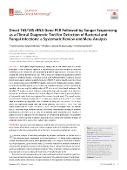Direct 16S/18S rRNA Gene PCR Followed by Sanger Sequencing as a Clinical Diagnostic Tool for Detection of Bacterial and Fungal Infections: a Systematic Review and Meta-Analysis

Autor
Hollweck, Regina
Lorenz, Michael G
Lustig, Michael
Bjarnsholt, Thomas
Datum vydání
2023Publikováno v
Journal of Clinical MicrobiologyRočník / Číslo vydání
61 (9)ISBN / ISSN
ISSN: 0095-1137Informace o financování
MSM//LX22NPO5103
FN/I-FN/I-FNM
Metadata
Zobrazit celý záznamKolekce
Tato publikace má vydavatelskou verzi s DOI 10.1128/jcm.00338-23
Abstrakt
rRNA gene Sanger sequencing is being used for the identification of cultured pathogens. A new diagnostic approach is sequencing of uncultured samples by using the commercial DNA extraction and sequencing platform SepsiTest (ST). The goal was to analyze the clinical performance of ST with a focus on nongrowing pathogens and the impact on antibiotic therapy. A literature search used PubMed/Medline, Cochrane, Science Direct, and Google Scholar. Eligibility followed PRISMA-P criteria. Quality and risk of bias were assessed drawing on QUADAS-2 (quality assessment of diagnostic accuracy studies, revised) criteria. Meta-analyses were performed regarding accuracy metrics compared to standard references and the added value of ST in terms of extra found pathogens. We identified 25 studies on sepsis, infectious endocarditis, bacterial meningitis, joint infections, pyomyositis, and various diseases from routine diagnosis. Patients with suspected infections of purportedly sterile body sites originated from various hospital wards. The overall sensitivity (79%; 95% confidence interval [CI], 73 to 84%) and specificity (83%; 95% CI, 72 to 90%) were accompanied by large effect sizes. ST-related positivity was 32% (95% CI, 30 to 34%), which was significantly higher than the culture positivity (20%; 95% CI, 18 to 22%). The overall added value of ST was 14% (95% CI, 10 to 20%) for all samples. With 130 relevant taxa, ST uncovered high microbial richness. Four studies demonstrated changes of antibiotic treatment at 12% (95% CI, 9 to 15%) of all patients upon availability of ST results. ST appears to be an approach for the diagnosis of nongrowing pathogens. The potential clinical role of this agnostic molecular diagnostic tool is discussed regarding changes of antibiotic treatment in cases where culture stays negative.
Klíčová slova
added value of sequencing, agnostic molecular diagnosis, bacterial meningitis, change of antibiotic treatment, culture-negative infections, fastidious and rare pathogens, infectious endocarditis, joint infections, nongrowing pathogens, sepsis
Trvalý odkaz
https://hdl.handle.net/20.500.14178/2115Licence
Licence pro užití plného textu výsledku: Creative Commons Uveďte původ 4.0 International







